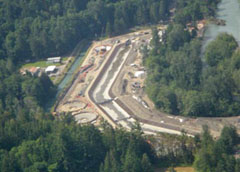 |
 | |
  | |
|
|
|
|
Olympic National Park
Elwha Water Facilities
|
|
|
|
|
| |
 |
 |
| Elwha Water Facilities under construction in June 2008. |
 |
Elwha Water Facilities
The Elwha Water Facilities includes several component projects:
Elwha Surface Water Intake (ESWI)
Elwha Water Treatment Plant (EWTP)
Area Flood Protection
The Elwha River Ecosystem and Fisheries Restoration Act of 1992 requires “protection of the existing quality and availability of water from the Elwha River for municipal and industrial uses from [the] possible adverse impacts of dam removal” (Section 4(a)(3)). In the 90-plus years since the dams were built, large amounts of sediment have accumulated at the bottom of the two reservoirs, most of it in a delta at the head of Lake Mills. Extensive testing and modeling has shown that protection measures are necessary to meet the requirements of the Elwha Act.
|
|
Elwha Surface Water Intake:
ESWI refers collectively to the surface water diversion and intake facilities. The intake facility will be located at river mile 3.48. During dam removal, water will be diverted to the Elwha Water Treatment Plant. Following dam removal, water will be diverted directly into the city’s industrial water channel.
|
 |
| Water quality mitigation is the last step in protecting the city and the fish stocks from impacts of dam removal. |
 |
The Elwha Water Treatment Plant:
The EWTP will maintain existing turbidity levels by removing sediment released downstream during removal of the two dams. The plant is being constructed near the industrial water channel at river mile 2.8. The facility is designed to remove sediment from the water supply for the Lower Elwha Klallam Tribal fish hatchery, the Washington Department of Fish and Wildlife (WDFW) fish rearing channel, and the Nippon Paper Industries mill, and when needed to the PAWTP for further treatment for municipal use.
During high turbidity, it would allow the city to turn off the Ranney collector pumps to prevent plugging of the subsurface gravels. When times of high turbidity pass, the city could again send water from the Ranney collector to the PAWTP. Water treatment for the Lower Elwha Klallam Tribe fish hatchery and the WDFW rearing channel is necessary in order to protect anadromous fish stocks. The EWTP will supply filtered water for the hatchery and rearing channel in order to protect the fish from adverse conditions that may likely arise during dam removal. During dam removal, a portion of the rearing channel production of Elwha Chinook salmon will occur in off-channel ponds near Morse Creek.
The high sediment transport period is expected to last from three to five years, depending on stream flows during that time. Higher stream flows would erode the sediments downstream faster than lower flow periods. The EWTP will only operate only during this three to five year period.
|
|
Area Flood Protection:
This measure will maintain protection for the new and existing facilities in the area, including the EWTP, Ranney Collector, and the Washington Department of Fish and Wildlife’s fish rearing channel. As sediments once again accumulate in the river below the dams, the river bed will raise to historic levels. Flood levels will rise to these historic levels, so protection from this river bed rise is being provided to maintain existing levels of flood protection.
Useful Links:
Learn more about the EWF construction contract.
Learn more about the EWTP and ESWI in the Elwha River Ecosystem Restoration Implementation Final SEIS (pdf).
|
|
|
|

Elwha Construction Contracts
Info on recent Elwha Restoration construction contracts.
more... | | 
Elwha Restoration Docs
EISs, technical reports and more
more... | | 
Elwha Resources & Tools for Teachers and Students
Link to Elwha River Education website
more... | | 
Historic Fish Runs in the Elwha
Click here to learn more about historic fish runs before dam construction!
more... | |
|
|
|
|
|
|
|
 |
|
Did You Know?
Although related to other marmots and groundhogs of North America, the Olympic marmot is unique. An endemic species, it is found only in the Olympic Mountains. Visitors to the high country of Olympic National Park may be lucky enough to encounter a marmot sunning itself near its burrow.
|
|
|
|
Last Updated: February 02, 2009 at 19:03 EST |






